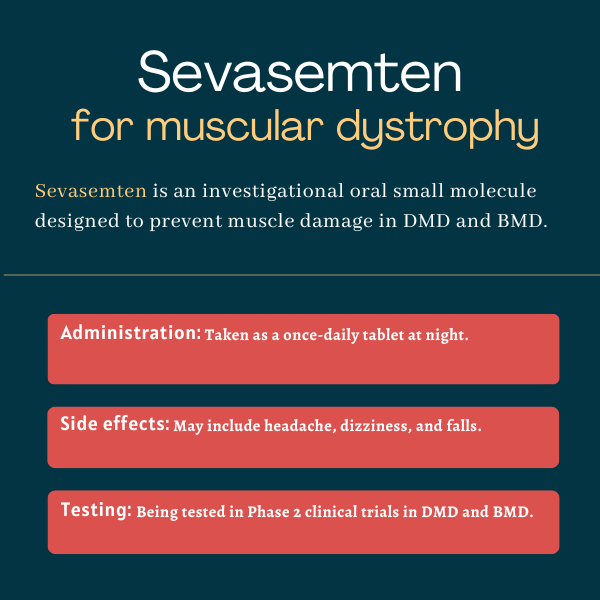Sevasemten for Duchenne muscular dystrophy
Last updated Aug. 18, 2025, by Margarida Maia, PhD

What is sevasemten for Duchenne muscular dystrophy?
Sevasemten is an oral small molecule being developed by Edgewise Therapeutics to prevent muscle damage in people with Duchenne muscular dystrophy (DMD) and Becker muscular dystrophy (BMD).
DMD and BMD are types of muscular dystrophy caused by mutations in the DMD gene, which encodes dystrophin, a protein that protects muscles during movement. Without it, the body’s muscles, especially skeletal muscles involved in voluntary movements, become damaged over time. This leads to a gradual loss of muscle strength.
Muscles are made of fibers that contract at different speeds: Slow-twitch fibers support sustained, endurance activities while fast-twitch fibers produce quick, powerful bursts but are more susceptible to damage. Sevasemten is designed to reduce how strongly these fibers contract by blocking myosin, a protein needed for muscle contraction. This helps protect muscles from damage while still allowing them to function. Because the therapy targets fast-twitch fibers, it should not affect the heart or other smooth muscles.
Therapy snapshot
| Treatment name: | Sevasemten |
| Administration: | As a tablet by mouth |
| Clinical testing: | In Phase 2 clinical testing for DMD and BMD |
How will sevasemten be administered?
Sevasemten is being developed in the form of an oral tablet to be taken at night. After testing sevasemten at a once-daily dose of 10, 15, or 20 mg in a Phase 1 clinical trial in adults with BMD, Edgewise selected the 10 mg dose for Phase 2 clinical testing. In children and adolescents with DMD, the company is now testing sevasemten at two doses to determine which may work best.
Sevasemten in clinical trials
Sevasemten first was shown to be well tolerated and to prevent a small group of men with BMD from experiencing a decline in motor function over at least two years in an open-label Phase 1 clinical trial called ARCH (NCT05160415). The company then began Phase 2 clinical testing in both BDM and DMD.
- A now-complete Phase 2 clinical trial called CANYON tested sevasemten in 40 men and 29 adolescent boys with BMD. As part of the clinical trial, participants were randomly assigned to receive sevasemten once daily (10 mg in adults, 5 mg or 12.5 mg in adolescents), or a placebo, for one year. CANYON met its main goal by reducing creatine kinase — a biomarker of muscle damage — by 28% with sevasemten compared with the placebo.
- CANYON later expanded into the pivotal, ongoing, GRAND CANYON study (NCT05291091), slated to run through 2026, in which 120 more men with BMD are receiving either sevasemten or a placebo for 18 months. In addition to measuring creatine kinase, a main goal is to test if sevasemten can prevent a decline in North Star Ambulatory Assessment (NSAA) scores — a measure of motor function in which higher scores indicate better performance — over the 1.5-year period. Top-line data, expected by late 2026, could support a marketing application, if positive.
- Patients who complete ARCH, CANYON, or GRAND CANYON have an option to enter an open-label extension called MESA (NCT06066580) in which all participants receive sevasemten for up to three years more. Early data suggest sevasemten continues to keep the disease stable, preventing a decline in motor function over time.
- Sevasemten is also being tested in LYNX (NCT05540860), a two-part Phase 2 clinical trial that recruited 76 boys with Duchenne, ages 4 to 9. Some of the participants are on a stable dose of corticosteroids. During the first part, which runs for 12 weeks, or about three months, patients are randomly assigned to receive sevasemten once daily at one of multiple doses, or a placebo. The second part is an open-label extension in which all participants are given sevasemten for an additional 21 months. The main goal is to assess safety for up to 24 months, or two years. Secondary goals include measuring biomarkers of muscle damage and assessing sevasemten’s pharmacokinetics, or how it moves into, through, and out of the body. According to Edgewise, preliminary results from functional measures identified a dose of 10 mg to evaluate in a Phase 3 study.
- The company is also running FOX (NCT06100887), a Phase 2 clinical trial assessing biomarkers of muscle damage, pharmacokinetics, and motor function, as well as the therapy’s safety, in 43 boys with DMD. The participants, ages 6 to 14, also had received gene therapy. After being randomly assigned to receive the medication or a placebo for 12 weeks, patients then continue on to an open-label extension in which all will receive sevasemten for an additional nine months. The study’s aim is to gain further insights into the treatment candidate’s safety and efficacy. Early results suggest that sevasemten, at 10 mg, may reduce the rate of functional decline.
Sevasemten side effects
The most common side effects reported with sevasemten during clinical testing include:
- headache
- dizziness
- falls
- COVID-19
- common cold
- fatigue
- somnolence or daytime sleepiness
Muscular Dystrophy News is strictly a news and information website about the disease. It does not provide medical advice, diagnosis, or treatment. This content is not intended to be a substitute for professional medical advice, diagnosis, or treatment. Always seek the advice of your physician or other qualified health provider with any questions you may have regarding a medical condition. Never disregard professional medical advice or delay in seeking it because of something you have read on this website.

